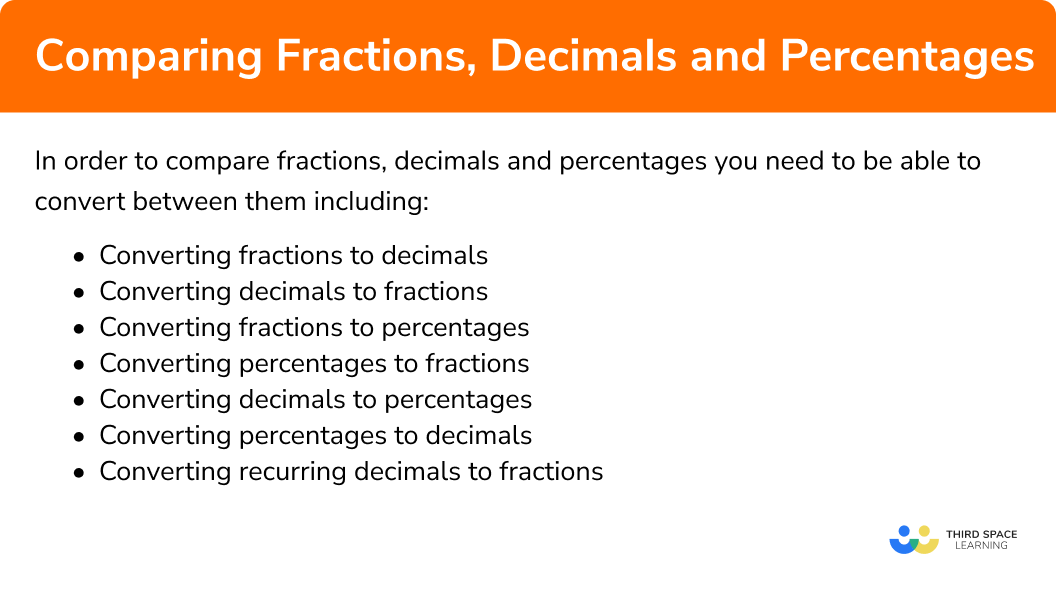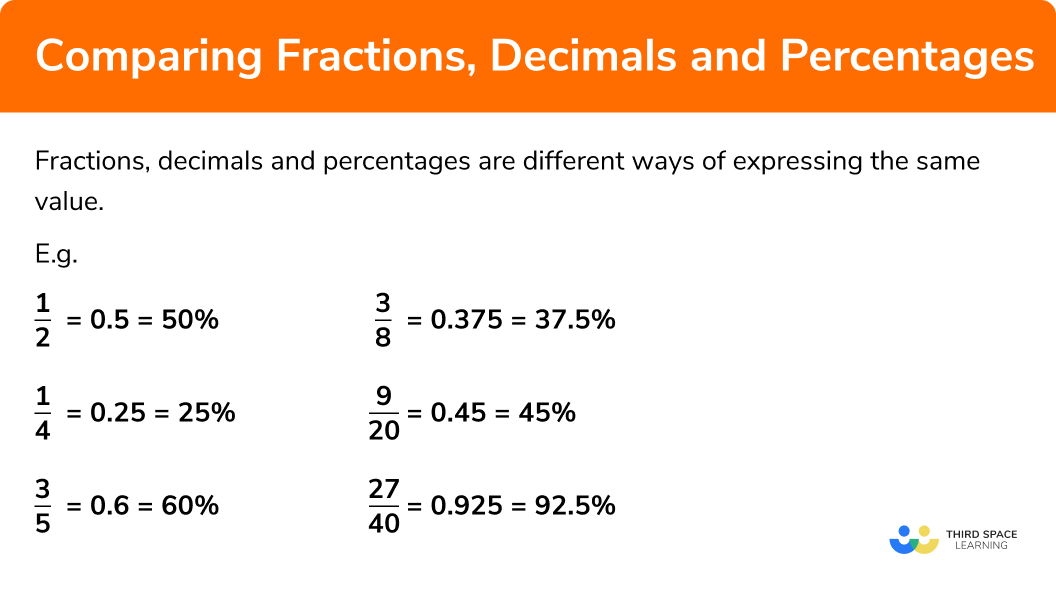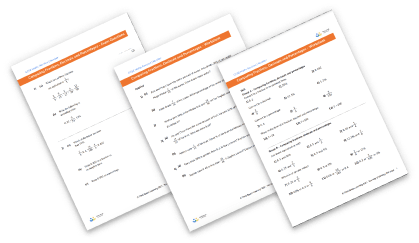One to one maths interventions built for KS4 success
Weekly online one to one GCSE maths revision lessons now available
In order to access this I need to be confident with:
Equivalent fractions Ordering fractions Decimal number line To the power ofThis topic is relevant for:

Converting Fractions, Decimals and Percentages
Here we will learn about converting fractions, decimals and percentages, including how to define a fraction, a decimal and a percentage, convert between fractions, decimals and percentages and compare and order them.
There are also converting fractions, decimals and percentages worksheets based on Edexcel, AQA and OCR exam questions, along with further guidance on where to go next if you’re still stuck.
How to convert fractions, decimals and percentages
In order to compare fractions, decimals and percentages you need to be able to convert between them. On this page we will explore how to convert between fractions, decimals and percentages step by step with examples.
Here is a summary
- To convert a fraction to a decimal divide the numerator by the denominator.
- To convert a fraction to a percentage divide the numerator by the denominator and multiply by 100.
- To convert a decimal to a percentage multiply the decimal by 100.
- To convert a percentage to a decimal divide the percentage by 100.
- To convert a percentage to a fraction divide the percentage by 100, write as a fraction, simplify the fraction
- To convert a decimal to a fraction: write the decimal as a fraction by dividing by 1, convert the numerator to an integer (by multiplying by a multiple of 10), multiply the denominator by the same amount (to create an equivalent fraction), simplify the fraction.
- To convert a recurring decimal to a fraction the calculation is more complex:
- Assign the recurring decimal to an unknown value e.g x.
- Multiply x (and the recurring decimal) by a base of 10 so you can eliminate the recurring part of the decimal by subtraction.
- Subtract your values of x and respective recurring decimals.
- Divide by the coefficient of x.
- Simplify the fraction where possible.
Name 7 ways to convert between fractions, decimals and percentages

Key facts about converting fractions, decimals & percentages
Fractions, decimals and percentages are different ways of expressing the same value
Fraction:
- A fraction results from dividing one integer by another:
E.g.
means
The numerator refers to how many ‘parts’ we have and the denominator refers to how many ‘parts’ there are in total. So here we have 1 out of 4 parts.
We need to equate denominators when converting fractions.
- When verbalising fractions we can refer to them in different ways:
E.g.
can be verbalised as “three out of eight” or “three eighths”.
- Some fractions have specific names which you will already be familiar with:
E.g.
is known as “one quarter”.
Note: The line in a fraction is called the vinculum.
Note: Any value that can be written as a fraction is called a ‘rational number.’
Decimal:
Numbers containing a decimal point are often referred to as “decimals”.
E.g.
Note: The word decimals comes from the Latin decima meaning a tenth. This is why the numbers after the point represent ‘tenths’, ‘hundredths’ and so on.
Percentage:
A percentage represents a number out of
E.g.
Note: The
Converting Fractions, Decimals and Percentages

Listing in order fractions, decimals and percentages
Fractions, decimals and percentages are all equivalents of each other, so we can order them by converting them into the same form.
E.g.
Write these numbers in ascending order.
Converting the fractions and decimals to percentages gives
Ascending means smallest to biggest, the smallest percentage is 19% = 0.19, the biggest percentage is 30% = 0.3.
In ascending order
Let’s explore below how we can convert between fractions, decimals and percentages.
Converting fractions, decimals and percentages step by step
In order to compare fractions, decimals and percentages you need to be able to convert between them. Here we will explore step by step how to convert between the following:
- Converting fractions to decimals.
- Converting decimals to fractions.
- Converting fractions to percentages.
- Converting percentages to fractions.
- Converting decimals to percentages.
- Converting percentages to decimals.
- Converting recurring decimals to fractions.
1. Convert a fraction to a decimal
In order to convert a fraction to a decimal:
Divide the numerator by the denominator.
E.g.
(Use a written method or a calculator)
Step by step guide: Fraction to decimals
2. Convert a decimal to a fraction
In order to convert a decimal to a fraction in its simplest form:
- Write the decimal as a fraction by dividing by
1 . - Convert the numerator to an integer (by multiplying by a multiple of
10 ). - Multiply the denominator by the same amount (to create an equivalent fraction).
- Simplify the fraction.
E.g.
Step by step guide: Decimals to fractions
3. How to convert a fraction to a percentage
In order to convert a fraction to a percentage:
- Divide the numerator by the denominator.
- Multiply by
100 .
E.g.
Or:
- Convert the fraction so the denominator is
100 (not always possible). - Write as a percentage because it is ‘out of
100 ’.
E.g
Step by step guide: Fractions to percentages
4. How to convert a percentage to a fraction
In order to convert a percentage to a fraction:
- Divide the percentage by
100 . - Write in fraction form.
- Simplify the fraction if required.
E.g.
Step by step guide: Percentages to fractions
5. How to convert a decimal to a percentage
In order to convert a decimal to a percentage:
Multiply the decimal by a
E.g.
Step by step guide: Decimals to percentages
6. How to convert a percentage to a decimal
In order to convert a percentage to a decimal:
Divide the percentage by
E.g.
Step by step guide: Percentages to decimals
7. How to convert a recurring decimal to fraction
In order to convert a recurring decimal to fraction:
- Assign the recurring decimal to an unknown value e.g
x . - Multiply
x (and the recurring decimal) by a base of10 so you can eliminate the recurring part of the decimal by subtraction. - Subtract your values of
x and respective recurring decimals. - Divide by the coefficient of
x . - Simplify the fraction where possible.
E.g.
Step by step guide: Recurring decimals to fractions
How to compare fractions, decimals and percentages
In order to compare fractions, decimals and percentages:
- Convert all the values into the same form (i.e. fractions, decimals or percentages).
Note: Which one you convert to may differ based on the question and context.
– If working with fractions; convert so all fractions have a common denominator.
– If working with decimals; write all values in a vertical line ensuring the decimals places are aligned.
– If working with percentages; check they all are out of100 .
– If fractions compare the numerators (denominators must be equal).
– If decimals compare the units, tenths, hundredths etc.
– If percentages compare the value before the% sign.- Check you have answered the question e.g. are they in ascending order?
- Write all values in their original form.

Comparing fractions, decimals and percentages worksheet

Get your free comparing fractions, decimals and percentage worksheet of 20+ questions and answers. Includes reasoning and applied questions.
DOWNLOAD FREE
Comparing fractions, decimals and percentages worksheet

Get your free comparing fractions, decimals and percentage worksheet of 20+ questions and answers. Includes reasoning and applied questions.
DOWNLOAD FREEKey terminology for converting fractions, decimals and percentages
Integer
A whole number
E.g.
Comparing
Examining the differences between two or more items/values.
Equivalent fraction
Fractions that are of the same value but shown differently
E.g.
Therefore,
are equivalent fractions.
Unit fraction
A fraction with 1 as its numerator is sometimes called a ‘unit fraction’:
E.g.
is a unit fractions because its numerator is
Unlike denominators
Fractions with non-identical denominators are sometimes called unlike denominators. When comparing fractions we need a common denominator (sometimes called like denominators):
E.g.
are unlike denominators because the bottom numbers of each fractions are not the same.
Improper fraction
A fraction where the numerator is greater than the denominator
E.g.
Mixed number
A number made up of an integer and a fraction
E.g.
Convert
To change between one form and another
E.g.
Recurring decimal
A decimal number with a digit (or group of digits) that repeats forever. The part that repeats can also be shown by placing dots over the first and last digits of the repeating pattern:
E.g.
Note: this are sometimes called repeating decimals
Ascending order
Increasing in value.
Descending order
Decreasing in value.
Converting and comparing fractions, decimals and percentages examples
Example 1: comparing fractions and decimals
Place these fractions and decimals in ascending order:
- Convert all the values into the same form: fractions, decimals or percentages.
As the two of the values are all fractions so we can convert the single decimal to fraction form.
2Convert all the fractions so they have a common denominator.
As you are comparing fractions you need to find a common denominator for the three fractions, we can do this by finding the lowest common multiple of
Therefore the common denominator is
Let’s now convert each fraction to have a denominator of
3Compare the numerators (denominators must be equal).
As the fractions now have a common denominator we can compare the different numerators:
4Check you have answered the question e.g. are they in ascending order?
The ascending order is:
5Write all values in their original form.
The fractions and decimals in ascending order are:
Example 2: comparing decimals and percentages
Place these in descending order:
Convert all the values into the same form: fractions, decimals or percentages.
Three of the values are decimals and one is a percentage so we can convert the single percentage to a decimal.
Write all values in a vertical line ensuring the decimals places are aligned.
The best way to compare decimals is to write all values in a vertical line ensuring the decimals places are aligned (see below):
Compare the units, tenths, hundredths etc.
Create a place value table and put each number in:
| Units | Decimal Point | Tenths | Hundredths | Thousandths |
| 0 | . | 7 | ||
| 0 | . | 7 | 7 | |
| 0 | . | 0 | 7 | |
| 0 | . | 0 | 7 | 7 |
Fill in the empty spaces with a zero:
| Units | Decimal Point | Tenths | Hundredths | Thousandths |
| 0 | . | 7 | 0 | 0 |
| 0 | . | 7 | 7 | 0 |
| 0 | . | 0 | 7 | 0 |
| 0 | . | 0 | 7 | 7 |
We can now easily compare the values.
Check you have answered the question
The descending order is:
Write all values in their original form.
The decimals and percentage in descending order are:
Example 3: comparing percentages and fractions
Place these in ascending order
Convert all the values into the same form: fractions, decimals or percentages.
Three of the values are percentages and one is a fraction so we can convert the single fraction to a percentage.
With percentages; check they all are out of 100.
As all the percentages are shown with the
Compare the value before the % sign.
Because each percentage is out of
We can see that
Check you have answered the question
The ascending order is
Write all values in their original form.
The ascending order is:
Example 4: comparing fractions, decimals and percentages (simple)
Place these in ascending order:
Convert all the values into the same form: fractions, decimals or percentages.
The three values given are in different forms, you therefore need to write them in the same form. In this example we will use decimals as the common form but you could use fractions or percentages.
Let’s convert each value to a decimal
Write each out value
So the three values as decimals form are:
Check you have answered the question
The values in ascending order are:
Write all values in their original form.
The values in ascending order are:
Extra: try this questions again using fraction or percentages as your common form.
Example 5: comparing fractions, decimals and percentages
Place these in ascending order:
Convert all the values into the same form: fractions, decimals or percentages.
The three values given are in different forms, you therefore need to write them in the same form. In this example we will use percentages as the common form but you could use decimals or fractions.
With percentages; check they all are out of 100.
As all the percentages are shown with the
Compare the value before the % sign.
Because each percentage is out of
We can see that
Check you have answered the question e.g. are they in ascending order?
The ascending order is:
Write all values in their original form.
The ascending order is:
Extra: try this questions again using decimals or fractions as your common form
Common misconceptions
- Converting
Incorrect conversion between fractions, decimals and percentages will result in the incorrect answer.
- Comparing decimals
Not taking place value into account when comparing decimals will result in the incorrect answer.
E.g.
- Comparing fractions
Not finding a common denominator when comparing and ordering fractions will result in the incorrect answer .
- Ascending/descending
A common error is to confuse ascending and descending.
Practice comparing fractions, decimals and percentages questions
1. Which of the below is not equivalent to 50\%?




\frac{5}{100} as a percentage is 5\% because \% means out of 100 .
Therefore \frac{5}{100} ≠ 50\%
2. Which of the below is not equivalent to \frac{1}{4}?




4\% is equal to \frac{4}{100} which when simplified is \frac{1}{25} ≠ \frac{1}{4}
3. Which of the below is not equivalent to 0.2?




2 \%=\frac{2}{100}=0.02 ≠ 0.2
4. Which value below is greater than \frac{2}{3}?




70 \%=\frac{70}{100}=\frac{7}{10}=\frac{21}{30}
\frac{2}{3}=\frac{20}{30}
Therefore, \quad \frac{21}{30}>\frac{20}{30}
Therefore, \quad \frac{7}{10}>\frac{2}{3}
Therefore, \quad 70 \%>\frac{2}{3}
5. Place these in ascending order 0.3, 32\%, \frac{31}{100}




So the numbers in ascending order are 0.3, \frac{31}{100}, 32 \%
6. Place these in descending order \frac{8}{9}, 90 \%, 0.89



They are equivalent

So the numbers in descending order are 90\%, 0.89, \frac{8}{9}
Comparing fractions, decimals and percentages GCSE questions
1. Write these numbers in ascending order:
0.82, \quad \frac{4}{5}, \quad 85 \%, \quad \frac{2}{3}, \quad \frac{7}{8}
(3 marks)
Attempt to convert all values to the same format with at least one conversion correct carried out.
(1)
Smallest and largest values:
\frac{2}{3} – smallest
\frac{7}{8} – largest
(1)
Correct order with all given in original form:
\frac{2}{3}, \quad \frac{4}{5}, \quad 0.82, \quad 85 \%, \quad \frac{7}{8}
(1)
2. Write these numbers in ascending order:
70 \%, \quad \frac{3}{4},\quad 0.6, \quad \frac{2}{3}
(3 marks)
Attempt to convert all values to the same format with at least one conversion correct carried out.
(1)
Smallest and largest values:
0.6 – smallest
\frac{3}{4} – largest
(1)
Correct order with all given in original form:
0.6, \quad \frac{2}{3}, \quad 70 \%, \quad \frac{3}{4}
(1)
3. Write these numbers in ascending order:
0.4, \quad \frac{7}{15},\quad 35 \%, \quad \frac{3}{7}
(3 marks)
Attempt to convert all values to the same format with at least one conversion correct carried out.
(1)
Smallest and largest values:
35 \% – smallest
\frac{7}{15} – largest
(1)
Correct order with all given in original form:
35 \%, \quad 0.4, \quad \frac{3}{7}, \quad
\frac{7}{15}
(1)
4. Jamaal received his scores for his recent tests:
– Art \quad \quad \quad \quad \quad \quad \quad \frac{14}{25}
– Biology \;\quad \quad \quad \quad \quad 64 \%
– German \quad \quad \quad \quad \quad\; 49 \%
– Sports Science \quad \quad \quad \frac{25}{43}
– Music \quad \quad \quad \quad \quad \quad \frac{11}{15}
– Physics \quad \quad \quad \quad \quad\; 54 \%
Arrange the subjects in order starting with the highest test score.
(3 marks)
Attempt to convert all values to the same format. with at least one conversion correct carried out
(1)
Smallest and largest values:
German 49 \% – smallest
Art \frac{14}{25} – largest
(1)
Correct order with all given (listed by subject):
Music, Biology, Sports Science, Art, Physics, German.
(1)
Learning checklist
You have now learned how to:
- Order positive and negative integers, decimals and fractions.
- Work interchangeably with terminating decimals and their corresponding fractions.
- Ordering fractions, decimals and percentages.
- Define percentage as ‘number of parts per hundred.
- Work with percentages greater than 100%.
- Compare fractions by using equivalent fractions.
- Compare fractions with different denominators by finding a common denominator.
The next lessons are
Still stuck?
Prepare your KS4 students for maths GCSEs success with Third Space Learning. Weekly online one to one GCSE maths revision lessons delivered by expert maths tutors.

Find out more about our GCSE maths tuition programme.